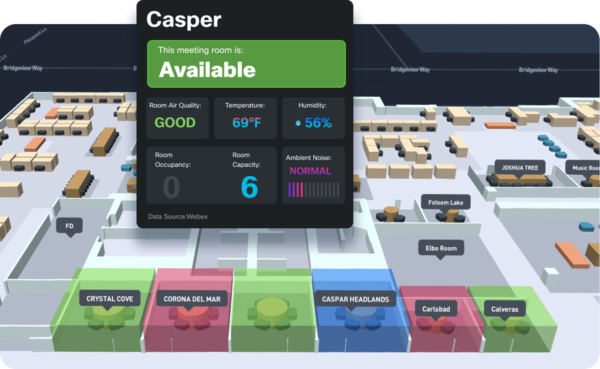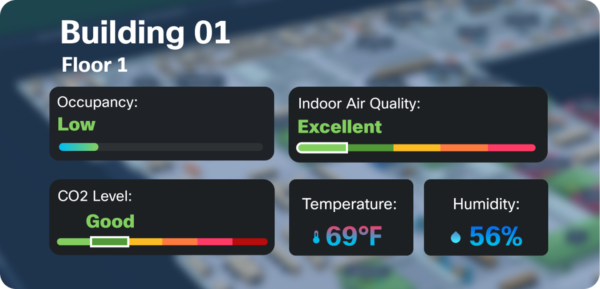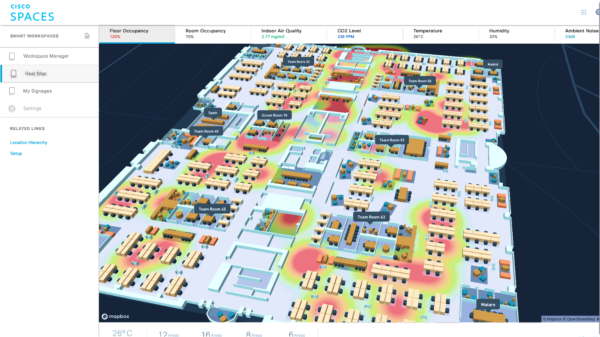Never have we seen such a seismic shift in the very definition of “going to work.” As hybrid work models expand, the role of the office is growing beyond the traditional notion of just being a physical space for work. Nowadays, the physical workspace needs to provide greater incentives for employees to visit—they need an experience that draws them back into the office and enables them to build relationships, collaborate, celebrate, and feel connected. With the rise of hybrid work, facilities must level up to these expectations—becoming safer, smarter, more sustainable, and more efficient in the process.
Reimagining the workplace
Some of the questions that IT and facilities leaders are puzzling over today are:
- How do we reimagine and redesign the office for hybrid work?
- How much space do we need?
- How do we optimize space to create experiences that engage and retain employees?
The key to answering these questions lies in reimagining the way we look at workplaces. Decisions on resizing and reconfiguring space cannot be driven by blind experiments. Critical data points on actual real estate utilization and occupancy levels are necessary to make informed decisions. These insights can contribute to multiple business and operational outcomes, including better space utilization, improved safety and well-being, energy optimization, and an improved visitor experience overall. These outcomes also support initiatives to make facilities more sustainable.
Your network as a sensor
Did you know that your Cisco network can act as a powerful sensor?
Cisco and Meraki access points, Meraki MT sensors, and Webex devices can go beyond connectivity to become sensors for occupancy and environmental conditions. Cisco Spaces taps into your existing Meraki infrastructure to make buildings smarter by providing greater visibility into space occupancy and utilization, enabling facilities and IT teams to boost productivity and improve employee experience.
By combining Cisco Spaces with the Meraki cloud platform, facilities and IT teams can bring together people, devices, and spaces to make buildings smarter, delivering the best experiences for everyone.



(Image 1) Live meeting room availability for a better employee experience. (Image 2) Real-time occupancy and air quality alerts to support safety and well-being. (Image 3) Occupancy heat map.
Rich employee experiences
Cisco Spaces creates a superior experience by transforming CAD (computer-aided design) maps of your building into 3D-rich maps, allowing users to visualize and locate points of interest, such as meeting rooms, desks, elevators, cafés, and restrooms. These maps are a canvas on which your hybrid workplace comes to life and can be used on Webex boards and other digital signage to provide contextual awareness.
Users can also use maps to visualize live meeting room availability and booking information, along with key environmental parameters such as temperature, humidity, and noise. They can temporarily hold meeting rooms until needed with the touch of a button on digital signage.
Safety and well-being
Cisco Spaces combined with Meraki Wi-Fi access points can enable real-time building and floor-occupancy monitoring. IT and facilities teams can set occupancy limits and get real-time notifications if thresholds are exceeded to avoid overcrowding and schedule facilities services based on true occupancy. They can also leverage Meraki MT sensors to get real-time environment updates (indoor air quality, temperature, humidity) across a specific building, floor, or meeting room, and also provide this information to employees.
Space utilization analytics
Facilities and real estate teams get real-time data and historical views to help simplify the complexity of reconfiguring and redesigning workspaces.
For example:
- Measure and visualize space occupancy and utilization over a 3D map to identify underused areas and discover opportunities to consolidate or reconfigure space
- Run A/B tests on the current space to measure the impact of at-location events and layout changes
- Monitor environmental conditions (air quality, temperature, humidity, etc) and energy consumption to drive sustainability
- Extend data outside Cisco Spaces into third-party apps and data lakes for more advanced analytics
The best thing about Cisco Spaces is that it’s approved by IT. With over 10,000 IT users, Cisco Spaces is secure, scalable, and offers 24/7 monitoring and support. Cisco Spaces also provides an open ecosystem that partners can build on.
Ready to transform your workplace?
Experience Cisco Spaces today: